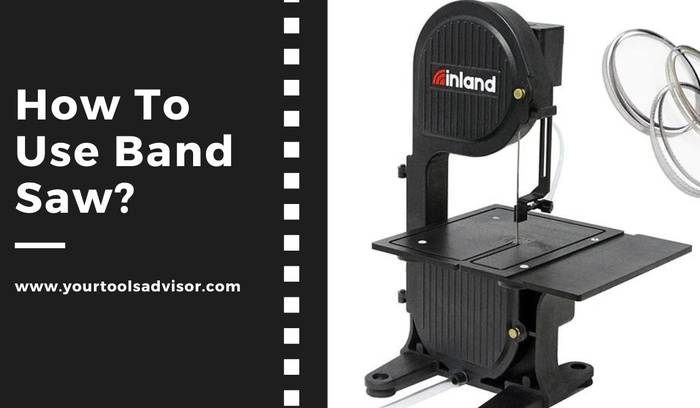If you’re a woodworking enthusiast, the band saw is a tool that can revolutionize the way you approach your projects. Its versatility, precision, and efficiency make it an indispensable addition to any workshop.
However, for those new to the world of woodworking, the band saw can seem like a complex and intimidating machine.
For the novice, one very common question that may pop up in mind is “how to use band saw?”
Well, fear not…
In this comprehensive guide, we’ll walk you through everything you need to know about using a band saw effectively and safely. From understanding its anatomy to mastering essential techniques, we’ve got you covered.
Whether you’re a novice looking to make your first cuts or an experienced woodworker aiming to refine your skills, this guide will serve as a valuable resource to help you unleash the full potential of this powerful tool.
So, whether you are a beginner or an experienced user, read on to learn the proper techniques for using a band saw effectively…
Basics of Band Saw
A band saw is a versatile cutting tool commonly used in woodworking and metalworking shops. It consists of a continuous band of toothed metal, called a blade, that moves around two wheels to make precise and controlled cuts through various materials.
One of the key advantages of a band saw is its ability to make intricate curved cuts, making it an indispensable tool for tasks like resawing (splitting boards into thinner pieces), contouring, and ripping. The blade’s teeth are available in different configurations, including fine-toothed blades for intricate work and coarse-toothed ones for rougher cuts.
Additionally, there are specialized band saws designed for specific tasks, such as vertical band saws for intricate detail work and horizontal band saws for cutting long, straight lines.
Why Do You Need Band Saw?
A band saw is an essential tool in woodworking and metalworking shops, valued for its versatility and precision. Its primary advantage lies in its ability to make intricate and curved cuts with ease.
Unlike other cutting tools, a band saw employs a continuous loop of toothed metal, allowing for smooth and controlled cuts through a variety of materials. This makes it indispensable for tasks such as crafting intricate furniture pieces, shaping curves in wooden projects, and even cutting metal stock.
Additionally, the adjustable speed settings and blade options of a band saw provide the user with a wide range of cutting capabilities, from delicate detail work to heavy-duty resawing.
Furthermore, the band saw’s design promotes safety and efficiency in the workshop. The downward cutting motion of the blade reduces the likelihood of kickback, a common hazard associated with other types of saws.
The stability provided by the large worktable ensures precise and controlled cuts, while the option to add various jigs and guides enhances accuracy even further. Additionally, modern band saws come equipped with features like dust collection systems, which help maintain a clean and safe working environment.
Whether you’re a professional craftsman or a DIY enthusiast, a band saw is an indispensable tool that significantly expands your capabilities in woodworking and metalworking projects.
How To Use Band Saw?
Using a band saw can be a useful skill for various woodworking and metalworking projects. Here’s a step-by-step guide on how to use a band saw safely and effectively:
Step 1: Gather Necessary Equipment and Safety Gear
Before you begin, make sure you have the following:
- Band saw
- Workpiece (the material you’ll be cutting)
- Safety glasses or goggles
- Ear protection (optional but recommended)
- Dust mask (if cutting materials that produce a lot of dust)
- Clamps (to secure the workpiece if necessary)
Step 2: Set Up the Band Saw
- Position the Band Saw: Place the band saw on a stable, level surface. Ensure there is enough space around the saw for you to move freely.
- Adjust the Blade Tension: Ensure the blade is properly tensioned according to the manufacturer’s instructions. An adequately tensioned blade will cut more accurately.
- Install the Correct Blade: Choose the appropriate blade for your specific cutting needs. Different blades are designed for cutting wood, metal, or other materials.
- Adjust the Blade Guides: Set the upper and lower blade guides close to the workpiece but without touching it. They should be adjusted so they provide support to the blade during the cut.
Step 3: Adjust the Table and Fence
- Set the Table Height: Adjust the table height so it’s just above the height of the workpiece. This allows for smoother cutting.
- Position the Fence: If you’re making a straight cut, adjust the fence to the desired distance from the blade. The fence acts as a guide to ensure straight cuts.
Step 4: Turn on the Band Saw and Make the Cut
- Turn on the Band Saw: Ensure the power is off before plugging in the band saw. Once plugged in, turn it on using the switch.
- Approach the Cut with Caution: Stand to the side of the blade, not directly in front of it. Keep your hands a safe distance away from the blade.
- Feed the Workpiece into the Blade: Slowly and steadily push the workpiece into the blade, keeping a controlled pace. Let the saw do the cutting, don’t force it.
- Maintain Steady Pressure: Apply even pressure throughout the cut. Avoid sudden movements or jerks.
- Use a Push Stick for Small Pieces: For small or narrow pieces, use a push stick to keep your fingers a safe distance from the blade.
Step 5: Complete the Cut
- Guide the Workpiece Through the Cut: Continue feeding the workpiece into the blade until the cut is complete.
- Turn off the Band Saw: Once the cut is finished, turn off the band saw and wait for the blade to come to a complete stop before removing the workpiece.
Step 6: Safety Precautions
- Wear Safety Gear: Always wear safety glasses or goggles to protect your eyes. Ear protection is also recommended due to the noise generated by the saw.
- Keep Hands Away from the Blade: Avoid reaching near the blade while it’s moving or immediately after a cut.
- Stay Focused: Pay attention to what you’re doing. Avoid distractions to prevent accidents.
- Clean Up: Remove any cutoffs and debris from the saw and work area.
By following these steps and practicing safe operating procedures, you’ll be able to use a band saw effectively and with confidence.
Remember, practice makes perfect, so take your time and gradually build up your skills.
Making Straight Cuts With Band Saw
Using a band saw to make straight cuts is an essential skill for any woodworker or DIY enthusiast. With the right technique and tools, you can achieve precise and clean cuts every time.
In this section, we will explore three key aspects of making straight cuts on a band saw: marking the cut line, using a fence or guide, and proper feeding of the workpiece.
Marking The Cut Line
Before making any cuts on a band saw, it’s crucial to mark the cut line accurately. This step ensures that you stay on track and achieve the desired result.
To mark the cut line:
- Measure and mark the dimension on the workpiece using a tape measure and pencil.
- Use a square to draw a straight line across the workpiece that aligns with your measurement.
- Double-check the alignment and adjust if necessary.
By following these steps, you can avoid veering off course and maintain control over the cutting process.
Using A Fence Or Guide For Straight Cuts
In addition to marking the cut line, using a fence or guide can significantly contribute to making straight cuts on a band saw. A fence is a fixed guide that helps keep the workpiece aligned during the cutting process.
To use a fence:
- Secure the fence to the band saw’s table, ensuring it is parallel to the blade.
- Adjust the distance between the fence and the blade according to your desired cut width.
- Place the workpiece against the fence, with the marked cut line aligned with the blade for a straight cut.
By utilizing a fence or guide, you can maintain consistent and precise cuts throughout your woodworking project.
Proper Feeding Of The Workpiece
Another crucial factor in achieving straight cuts on a band saw is the proper feeding of the workpiece. The way you feed the workpiece into the blade can impact the quality of the cut.
Here are some guidelines for proper feeding:
- Start with a slow and steady feed rate, allowing the blade to cut through the workpiece smoothly.
- Maintain a consistent feed rate throughout the cut, avoiding sudden or jerky movements.
- Ensure that the workpiece stays in contact with the fence or guide throughout the cutting process.
By following these feeding practices, you can prevent the workpiece from drifting and achieve cleaner, straighter cuts.
Curved Cutting Techniques With Band Saw
When it comes to using a band saw, mastering curved cutting techniques is essential. Whether you’re a beginner or an experienced woodworker, knowing how to make precise and smooth curved cuts can elevate your projects to the next level.
In this section, we will explore three methods that will help you achieve accurate and beautiful curved cuts: using a template or pattern, freehand cutting, and cutting circles and curves with a jig.
Using A Template Or Pattern
Making curved cuts with a band saw can be challenging, especially if you’re aiming for consistency. Using a template or pattern is a foolproof method to ensure accuracy and uniformity in your cuts.
Here’s a step-by-step guide on how to use this technique:
- Create or obtain a template or pattern that matches your desired curve. You can draw it on paper or use pre-made templates available online or in woodworking books.
- Secure the template to your workpiece using double-sided tape or clamps, ensuring it doesn’t move during the cutting process.
- Select a blade suitable for the thickness and type of material you’re working with. A narrower blade will allow tighter curves, while a wider blade is better for larger curves.
- Using the template as a guide, slowly and steadily feed your workpiece into the band saw blade. Let the blade do the cutting, and guide the material along the template’s edges to maintain the shape.
- Continue cutting until you’ve completed the desired curve, making sure to stay consistent in your feed rate and maintaining control throughout the process.
By following these steps and using a template or pattern, you can achieve precise and repeatable curved cuts with your band saw.
Freehand Cutting
If you’re comfortable with your skills and want to add some artistic flair to your projects, freehand cutting is a technique worth exploring. While it requires more practice and control, it allows for unique and organic curves.
Here’s how to get started:
- Mark the starting and ending points of your curve on the workpiece with a pencil or marking tool.
- Hold the workpiece firmly with one hand, keeping it stable and ensuring your fingers are well clear of the blade.
- With the band saw turned on, slowly and gently guide the workpiece through the blade, following the marked line.
- Use your other hand to provide additional support and control as needed, adjusting the angle of the cut as you go.
- Keep a steady pace and maintain your focus throughout the cutting process to achieve smooth and accurate curves.
Note that freehand cutting requires practice to develop a steady hand and precise control. It’s best to start with simpler curves and gradually work your way up to more intricate designs.
Cutting Circles And Curves With A Jig
If you need to cut consistent circles or larger curves, using a jig is a reliable method. A jig provides stability and allows you to pivot your workpiece precisely.
Follow these steps to cut circles and curves with a jig:
- Create a jig by attaching a pivot point to a wooden base or platform. The pivot point can be a screw, a dowel, or any other sturdy object that allows rotation.
- Measure and mark the radius of your desired curve on the workpiece.
- Position the workpiece on the jig, aligning your marked radius with the pivot point.
- Secure the workpiece to the jig using clamps or double-sided tape.
- Turn on the band saw and rotate the jig, allowing the blade to make the cut as the workpiece follows the curve.
Using a jig provides stability and control, resulting in accurate and smooth cuts for circles and larger curves.
Frequently Asked Questions
What Is The Proper Way To Use The Bandsaw?
To use a bandsaw properly, follow these guidelines: 1. Wear safety gear like goggles and gloves. 2. Adjust the blade tension and tracking. 3. Hold the workpiece firmly against the table and fence. 4. Use a slow, even feed rate to avoid blade binding. 5. Keep the work area clear and free from distractions.
What Is The Most Important Rule When Using The Band Saw?
The most important rule when using the band saw is to prioritize safety. Adhere to safety guidelines, such as wearing appropriate protective gear, maintaining a clear work area, and carefully following the manufacturer’s instructions. Safety should always come first when operating the band saw.
How Do You Use A Metal Band Saw?
To use a metal band saw, first, ensure the machine is properly set up and secured. Adjust the blade speed and feed rate based on the type and thickness of the metal. Position the material, aligning the cut line with the blade, and slowly feed it through while keeping a steady hand. Remember to wear safety equipment like goggles and gloves.
What is the most important rule when using the band saw?
The most important rule when using a band saw is to always prioritize safety. This includes wearing appropriate protective gear, maintaining a firm grip on the material, and using proper techniques to avoid accidents or injuries.
Conclusion
In conclusion, mastering the art of using a band saw can open up a world of possibilities for both novice and experienced woodworkers alike.
By understanding the basic components, safety measures, and techniques discussed in this guide, you’re well on your way to confidently and effectively operating this powerful tool. Remember, practice makes perfect, so start with simple projects and gradually work your way up to more complex cuts.
Always prioritize safety and take the time to maintain your band saw properly. With dedication and patience, you’ll soon be creating precise, intricate cuts that bring your woodworking projects to a whole new level.
Happy sawing!





Leave a Reply